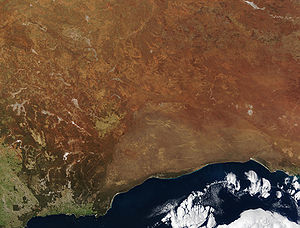Great Australian Bay
| Great Australian Bight. Great Australian Bight |
|
|---|---|
|
Great Australian Bight Marine Park |
|
| Waters | Indian Ocean |
| Land mass | Australia |
| Geographical location | 34 ° 48 '15 " S , 131 ° 4' 38" O |
|
The Nullarbor Desert, which takes up much of the coast |
|
The Great Australian Bight ( english Great Australian Bight ) is a large bay on the central and western parts of the south coast of Australia .
The bay belongs to the Indian Ocean . According to the definition of the International Hydrographic Bureau , the bay lies between West Cape Howe in Western Australia and South West Cape in Tasmania . Often, the Great Australian Bight only refers to the area between Cape Pasley in Western Australia and Cape Carnot on the Eyre Peninsula in South Australia . These two points are also 1,160 km apart.
The Great Australian Bight is very stormy during the winter months. Cold and warm currents meet in the Great Australian Bight . The waves are among the highest and most consistent in the world. The shelf is more than 200 km wide in certain places. Little fresh water flows into the Great Australian Bight, as very little rain falls in the areas around the bay and rainwater usually does not reach the sea.
The coast of the Great Australian Bight is characterized by high cliffs that reach heights of up to 60 m and beaches . Large parts of the coast are uninhabited, especially in the area of the Nullarbor Plain . Only the edges of the desert from the Eyre Peninsula and in the west from Esperance are sparsely populated. Important places in the narrower area of the Great Australian Bight are the fishing town of Port Lincoln on the southern tip of the Eyre Peninsula, Ceduna at its western end and little Eucla on the border between Western and South Australia. In the larger catchment area of the bay, the South Australian cities of Port Augusta in the Spencer Gulf and Adelaide with the metropolitan region on the Gulf of St. Vincent should be mentioned. In the far west one can also add the small towns Albany and Esperance according to the broader definition .
The seclusion and the different currents have created a rich biodiversity on the shelf, some of which are protected as national parks. Often there are small animals such as mollusks , starfish , sea urchins , seahorses , jellyfish , sea cucumbers and sea squirts , but also many algae and sea grasses that often only occur in the bay's unique ecosystem. The larger species of animals that inhabit the bay include sharks , little penguins , right whales and other marine mammals . Southern right whales calve in the bay and raise the calves here. The area was exploited by the fishing industry . Tuna in particular was fished a lot.
Numerous stretches of coastline are national parks and marine reserves , including the Far West Coast Marine Park (South Australia) and the federally administered Great Australian Bight Commonwealth Marine Reserve (they sometimes include the former Great Australian Bight Marine Park ), the Western Eyre Commonwealth Marine Reserve (Federal Government), Twilight Commonwealth Marine Reserve (Federal Government), Nullarbor National Park (South Australia), Nuyts Archipelago Conservation Park (South Australia), Nuyts Reef Conservation Park (South Australia), Investigator Group Wilderness Protection Area (South Australia), Coffin Bay National Park (South Australia), Whidbey Isles Conservation Park (South Australia), Nuytsland Nature Reserve (South Australia), Cape Arid National Park (Western Australia), Eucla National Park (Western Australia) and the Recherche Archipelago Nature Reserve (Western Australia) are among the most important.
Europeans first sailed the waters of the Great Australian Bight in 1627 , when the Dutch navigator François Thijssen and Pieter Nuyts , who first mapped the area , entered the bay from the west. It was first carefully mapped in 1802 by the English captain Matthew Flinders when he was sailing around the Australian continent. Edward John Eyre managed an expedition ashore .
Web links
- Great Australian Bight Commonwealth Marine Reserve (English)
- Far West Coast Marine Park (English)
- BBC : Wild Down Under ( Memento of February 14, 2009 in the Internet Archive ) (English)
Individual evidence
- ^ Far West Coast Marine Park. In: Department of Environment, Water and Natural Resources. Retrieved December 25, 2015 .


